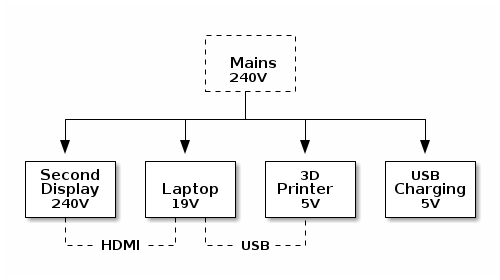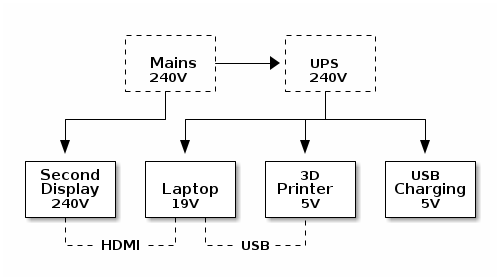 Coffee Space
Coffee Space 

As I spoke about previously, the EU has an energy crisis and things are about to get pretty bad. As such, I suspect we will soon see rolling blackouts as our infrastructure becomes too stressed during the winter 1.
As such, I believe people will start to get quite creative in the solutions that come up with to reliable power. Of course, the sort of power a house or workshop can draw is quite a lot, and therefore really quite dangerous. In this article I want to discuss some solutions, problems, and the future.
Firstly, a discussion about different power sources available.
A lot of people are looking at green energy alternatives. Here in the UK solar isn’t so great, especially during winter where we will likely see power outages as the grid becomes overwhelmed. Wind on the other hand is plenty!
One issue with renewable generation through is that it is far from reliable. You will very much want to either use the power as it is available (preferable), or store it in batteries.
One way to generate power is with some form of generator, which typically runs on some dinosaur juice. With the growing energy crisis, this is looking less and less like a viable option for most.
Some things to note about generators is that they can output three-phase at a scale large enough to run a house. You would need a converter to get it to two-phase. Another thing to note is that voltage and frequency can change based on load, so if your electronics are sensitive, take care.
Another consideration is that the switch-over will not be instant. Many generators will have to be manually started, and those that are automatic will take some time to start.
As eevBlog learned recently in his video “EcoFlow Delta Pro - RTFM Dummy!”, there is a difference between an EPS (emergency power supply) and UPS (uninterruptible power supply).
An EPS can provide power encase there is an outage, and can range in functions. Some will automatically switch on if the mains supply goes out, some will not. A UPS on the other hand will track mains voltage and look to match it immediately after the supply is lost.
The major difference is that an EPS will likely mean the device attached switches off, whereas a UPS is not supposed to allow for this to happen. The amount of load on the device will also make a difference here.
Uses for EPS:
Uses for UPS:
Both:
Worth noting is that a UPS or EPS could be a battery bank, or it could be an electric car.
The setup happens to be quite important, and quite a big concern for many.
Some people have simply been hooking up their backup supply straight to the mains of their house, as an easy to implement solution. As a recent Hackaday article points out, the US Consumer Product Safety Commission issued a warning on this.
Of course there is a major problem with this - it bypasses all of the electrical protections in your house (fuses, RCD, etc). It also back-feeds electric onto the grid, when it should be disconnected. People working on the electrical grid (which may be the reason for the power cut) could then be electrocuted.
Worse still, it’s entirely possible that when power is restored, you have two different high-power supplies out of phase. Without proper protection circuits, you could be looking at a very serious fire.
The better option is to have a pass-through system, where you hook up devices to an intermediate source that you want to remain powered during a cut. In my case this would be a UPS, but this could be any power supply.

I chose the Power Walker VI 650 SH, it was less than £50 delivered from Amazon 2 (although I suspect that there won’t be any left now). I’ve had it running on battery for a few minutes and it survived, so will survive 99% of the power cuts we currently experience.

The idea is that whilst mains is available, we use this and keep the battery bank topped off. Equally, you could have a setup with renewable energy that could prefer that source over mains whilst it is available, whilst topping up a battery.

One thing to watch is mixed power sources - as you can see here I run the display via mains (because I ran out of plugs on the UPS). The issue here is that potentially they do not have common earth. HDMI should be low risk and well isolated, but it could be a weakness.
Of course this only allows a handful of devices close to the UPS to be powered during an outage, not the whole house. If you want the UPS to run the entire house, you will need to do some serious electrical work and find a very beefy supply.
Houses in the future should support external power sources. Solar, generators, battery banks, cars, etc, could feed both the house and potentially back into the electrical grid. For this you will need:
In any cases, I believe houses of the future should embrace change, and this should be supported through regulation. We already know that the only way we meet the energy demands of the future is to decentralize the power grid somewhat and make use of these independent power sources efficiently.